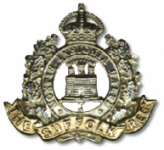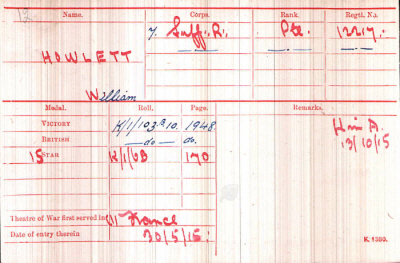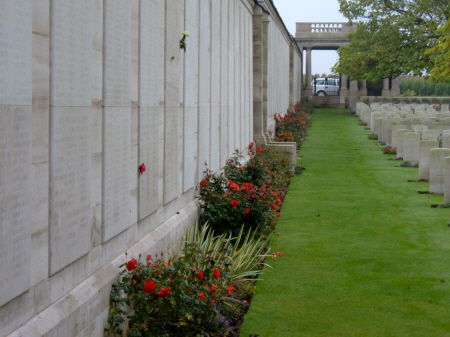

HOWLETT, William


No. 12217, Private, William Albert HOWLETT
Aged 20

7th Battalion, Suffolk Regiment
Killed in Action on Wednesday 13th October, 1915
|
Born Q2-1895 [Newmarket 3b:531] in Exning to William and Annie Louisa HOWLETT (née LANGLEY) of Quorn Terrace, Exning 1901 census...William [5] was at Quorn Terrace, Exning with his father [34], labourer, born Exning..his mother Annie [27] born Ashley and 2 lodgers. 1911 census...William apparently got himself recorded in the 1911 census at his parents and at his grandparent's house( where his Uncle Thomas, previous casualty, was living at the time). It is recorded that at Exning were William [15] a farm labourer, with his parents, sisters Cissie [7] and Ida [5] and brothers Christian [3] and Allen [7 months], all the children born in Exning. He was the nephew of Thomas Howlett and Abel Howlett With every generation having a boy named William this entailed very careful research, but the entry below does help clarify the family situation. Even "Our Exning Heroes" seems to mix up parts of the Howlett history. The date of his death from Army sources is 13th October 1915 which also matches with his mother's death, but "Our Exning Heroes" has William's death date wrong. He is entered as William Albert HOWLETT in the index of births. William's entry in "Our Exning Heroes" reads as follows: Howlett, William. 7th Suffolk. William Howlett lived most of his life with his grandparents, along the Burwell Road. His own parents lived in Bedlam Square. He joined up on the outbreak of the war in August, 1914, and was sent to France at the end of the year. He was killed instantaneously on April 9th, 1915, at the age of twenty-one. Before the war he worked as a labourer on Mrs. White's farm. He was fond of football. His mother died just about the same time that her son was killed, and never knew of his death. |

|
The 7th Battalion on the 13th October 1915 took part in the Action of the Hohenzollern Redoubt, capturing Gun Trench and the south western face of the
Hulluch Quarries. They took over in front of the Quarries from the 1st Guards Brigade on 12th October. At 2pm on 13th, the 7th Suffolks, after an intensive
barrage, launched an attack, on a front of about a mile, on the Quarries. The battalion objective was two trenches known as the Hairpin, running from the
British (the old German) front line to that of the enemy, about 250 yards. At the British end they were seperated from the frontline by bombing saps from 15
to 50 yards apart. "B" Coy advanced across the open under cover of smoke, but when this lifted they came under very heavy machine gun fire and the objective was not reached (they sustained 75 casualties). Meanwhile "A" Coy.,headed by a bombing party from the 7th Suffolks and 7th Norfolks attacked up the left arm, and "D" Coy., attacked up the right. Gradually, although now cut off from HQ, they forced their way up to the edge of the Quarries but the increasing opposition of the enemy prevented any further advance. A trench was dug linking the two arms, thus completing the "Hairpin". The position was now consolidated to be handed over later to the 9th Essex. This day the 7th Suffolks suffered 51 killed, none have identified graves, all are named on the Loos Memorial. During this period at Loos, 117 officers and 3237 men of the Division were killed or wounded. Private Eric Woollard was also killed on this day and is named on the Loos Memorial |


click here to go to the Commonwealth War Graves Commission website for full cemetery/memorial details